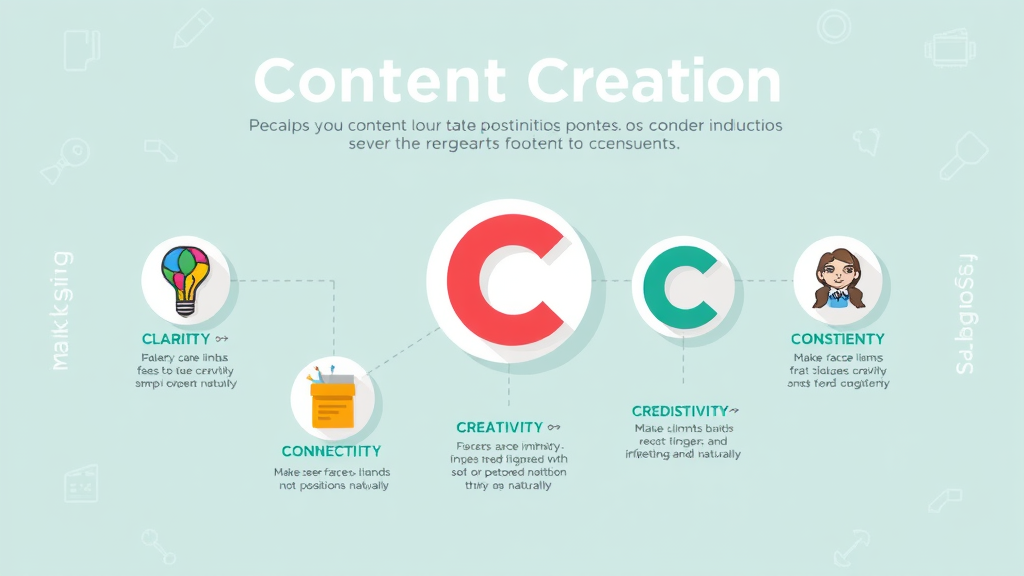Did you know that over 70% of marketers who embrace targeted content creation have reported their conversion rates have doubled? In the fast-paced world of digital marketing, generic messaging just doesn’t cut it anymore. Modern audiences demand content that feels made for them—content that speaks directly to their needs, solves their pain points, and inspires action.

- Grasp the impact of strategic content marketing on conversion rates
- Understand how to tailor your content strategy for diverse target audiences
- Discover actionable steps for creating content that resonates and converts
- Explore the role of buyer personas in refining targeted content creation
- Analyze top-performing content formats and channels for your marketing campaign
"Over 70% of marketers report that targeted content creation has doubled their conversion rates – making strategic content essential in today’s digital landscape."
Why Targeted Content Creation Drives Superior Results
Targeted content creation stands at the heart of every successful content marketing strategy. By understanding your target audience and delivering content that addresses their unique interests, challenges, and goals, brands see dramatic improvements in conversion rates and customer loyalty. Instead of oversaturating the market with broad messages, focused content ensures every blog post, campaign, or social media update serves a real purpose for a specific audience segment.
The science behind this approach is simple: people are more likely to engage and take action on relevant content that mirrors their pains, ambitions, and preferences. When you develop a content strategy that’s informed by data and built on actual audience insights, you move from guessing to engineering content that resonates deeply. For instance, an ideal customer looking for answers to a pain point in their business journey will find direct solutions through content specifically tailored for them, resulting in higher engagement rates and more conversions.
Moreover, aligning your messaging with the right content format —such as blog posts, infographics, or videos—in the right place and at the right time, amplifies results across your marketing efforts . This method transforms your brand from just a provider of information into a trusted advisor and thought leader, delivering valuable insights when and where they’re needed most.
Understanding Your Target Audience for Targeted Content Creation

The foundation for effective content creation begins with a deep understanding of your target audience . Creating content without assessing who you are speaking to is like preparing a speech for an empty room. To create content that truly resonates, brands must move beyond broad demographics to uncover the unique traits, motivations, and pain points of their audience segments.
This process involves leveraging customer data, digital analytics, and direct interactions to build a clear picture of your ideal customer . For instance, gathering behavioral patterns from your website, surveying existing customers about their needs, and examining feedback from social media channels all contribute to understanding your audience’s expectations and desires. Understanding your audience is also about predicting future trends—what will matter most to them tomorrow—and being ready to address those shifts in your content strategy.
Developing Buyer Personas to Tailor Your Targeted Content

Buyer personas are fictional yet data-backed profiles of your ideal target audience members. These personas go well beyond surface-level descriptions—they include demographic details, buying motivations, daily routines, key challenges, and decision-making processes. When you invest in developing robust buyer personas, you lay the groundwork for producing content that resonates at every stage of the buying journey.
Effective buyer personas answer crucial questions: What are the primary goals of your target audience? What obstacles or pain points prevent them from achieving those goals? What content formats do they prefer—do they enjoy in-depth blog posts, interactive webinars, or social media infographics? By answering these questions, your content creator team will have a roadmap for building tailored messaging that attracts, engages, and converts prospective customers.
Incorporating buyer personas into your content marketing strategy not only strengthens messaging clarity but also increases efficiency. You reduce wasted effort, refine distribution channels, and develop relevant content that compels action from each distinct audience segment.
Mapping Pain Points: Creating Content That Solves Real Problems
Every successful content marketing initiative begins with identifying and addressing the core pain points of your audience. Pain point mapping involves gathering insights into the chronic frustrations or unmet needs of your customers. For instance, are your potential customers struggling to choose the right digital tools, or do they face barriers implementing a new strategy? By mapping these issues, you can create content that offers real value—acting as a solution, not just another information source.
Use customer feedback, support tickets, social media comments, and market research to identify recurring issues. Incorporate these pain points into your content topics and headlines, positioning your brand as the problem solver. When your audience sees your content that speaks directly to their needs, the trust factor rises—which is critical in any marketing campaign .
Remember, actionable content is about showing—not just telling—prospects how to overcome obstacles. This is how you shift from shallow engagement to meaningful conversions within your content strategy .
Laying the Foundation: Aligning Content Strategy with Your Target Audience
How to Build a Winning Content Marketing Strategy

Building an effective content marketing strategy starts with setting clear objectives and aligning them with the needs of your target audience . First, define the key goals for your business, such as increasing website traffic, improving conversion rates, or establishing thought leadership. Next, research which topics, keywords, and pain points matter most to your potential customers by analyzing market data and competitor activity.
Developing a content calendar plays a significant role in keeping your messaging consistent and relevant. Use this plan to outline content formats (such as blog posts, social media updates, case studies, or videos), publishing dates, and promotional channels. By continuously refining your strategy based on real-time results and feedback, you can ensure each marketing effort is optimized for engagement and conversion.
Remember, a winning content strategy is agile—it adapts to shifting trends, audience behaviors, and platform algorithms, ensuring you create content that delivers sustainable value.
Choosing the Right Content Format for Compelling Content
Selecting the right content format for your message is just as critical as the message itself. Different buyers prefer different types of content at various stages of their journey—while some want detailed blog posts, others engage more with videos, infographics, or downloadable resources. To maximize results, start with your buyer personas and align each stage of the customer journey to the appropriate format.
For example, top-of-funnel prospects may gravitate toward quick tips on social media or infographic overviews, while decision-stage prospects seek in-depth case studies, whitepapers, or webinars. By offering a mix of content types, you satisfy diverse learning styles and dramatically improve engagement rates and conversions.
Regularly review analytics to see which formats and topics drive the most actions—and be prepared to pivot your content creation efforts for maximum impact.
Leveraging Social Media and Email Marketing for Targeted Content Creation
Integrating social media and email marketing into your content creation workflow extends the reach and impact of every campaign. Social media platforms allow you to engage directly with your audience, test content quickly, and go viral through shares and discussions. Segmenting your audience by platform and demographic ensures you deliver highly targeted content —not just mass messages—to those who are most likely to convert.
Meanwhile, email marketing remains one of the highest-converting channels for nurturing leads and customizing content journeys. Segment your subscriber lists based on buyer personas, interests, and previous interactions to send personalized email sequences that address relevant pain points . This one-to-one approach not only boosts open and click-through rates but also strengthens brand trust over time.
By combining both channels, you maximize your marketing efforts , creating a seamless path from discovery to conversion with targeted, compelling content at every touchpoint.
| Format | Purpose | Conversion Rate % |
|---|---|---|
| Blog Posts | Thought Leadership/SEO | 17% |
| Videos | Engagement/Education | 21% |
| Case Studies | Trust Building | 29% |
| Infographics | Simplifying Complex Info | 14% |
| Email Sequences | Personalization/Nurturing | 23% |

Content Creation Workflow: Crafting Targeted Content That Resonates
Steps for Creating Content That Converts
Transforming marketing goals into high-converting campaigns involves following a proven content creation workflow. The most successful brands rely on repeatable, data-driven processes that ensure each piece of content speaks directly to the target audience and aligns with business objectives.
- Define your target audience with data-driven insights
- Research buyer personas and core pain points
- Select content format and channel based on marketing strategy
- Develop compelling content with actionable messaging
- Distribute and promote via strategic marketing efforts
- Measure results and iterate your content strategy

Start each campaign by clarifying your ideal customer and audience segments. Dive deep into their preferences and pain points . Next, choose the most effective content format and marketing channel, be it a relatable blog post, targeted video, or educational email sequence. Always infuse your messaging with value, aiming to solve problems and guide readers to action.
After launch, monitor results to identify opportunities for rapid improvement. Agile marketing strategies rely on data, so use analytics to fine-tune your ongoing content creation and stay ahead of your competition.
Tools and Platforms: Enhancing Content Marketing Strategy

Empowering your content marketing strategy with the right tools is non-negotiable in today’s digital world. Analytical platforms like Google Analytics, HubSpot, and SEMrush offer actionable insights on what’s working by measuring engagement, traffic, and conversion metrics down to each types of content .
Content management systems (CMS) help streamline workflow from ideation to publication, while email marketing platforms can automate and personalize outreach. Social media management tools, such as Buffer or Hootsuite, allow you to schedule posts, monitor reactions, and measure engagement rates across platforms.
These tools not only save time but remove guesswork, letting you test and refine content that resonates with each audience segment for superior results.
Optimizing Targeted Content for Every Marketing Campaign
Refining Content Through Continuous Testing and Data

The secret to sustainable conversion rates lies in consistently optimizing your targeted content through data-driven experimentation. A/B testing headlines, calls-to-action, images, and formats within blog posts, social media, and email campaigns reveals which elements resonate highest with your target audience .
Integrate analytics into every stage of your content creation workflow to measure bounce rates, time-on-page, and click-through percentages. By regularly reviewing these metrics and acting on them, brands can sharpen their messaging and adjust their content marketing tactics in real time for continual improvement.
The key is to test one variable at a time and document findings. Over time, these micro-adjustments compound, leading to measurable lifts in engagement rates and marketing ROI.
Personalization Techniques for Creating Content That Resonates
Personalization is at the forefront of effective targeted content creation . Today’s customers expect content that acknowledges their unique interests and purchasing history. Use dynamic content, segmented email campaigns, and tailored recommendations based on behavior to deliver truly relevant content .
Leverage marketing automation tools to track user interactions and trigger relevant offers or information based on where someone is in their journey. For example, personalizing subject lines or recommending related blog posts can substantially boost open and conversion rates.
By continually refining these techniques, you create a feedback loop that deepens trust, increases lifetime value, and positions your brand as a market leader.
"Content that resonates isn’t guessed — it’s engineered through strategic audience insights and agile content creation." – Leading Content Creator
Case Studies: Targeted Content Creation Success Stories

How Top Brands Use Targeted Content to Increase Engagement
Leading global brands are reaping major rewards from targeted content creation . For instance, a major sports apparel company segmented its audience segments by athletic interest and rolled out tailored campaigns for runners, basketball enthusiasts, and gym-goers. As a result, they saw a 40% increase in engagement rates because each campaign spoke directly to each segment’s needs and aspirations.
Another SaaS company mapped individual customer pain points and produced a resource center addressing each challenge, tying content pieces to specific buyer personas. Organic traffic increased by 120% within six months, while qualified leads doubled. These outcomes underscore how data-driven strategies, deep customer insights, and tactical content distribution propel brands ahead of the competition.
The key takeaway: the most successful content marketing is always audience-first, targeted, and continuously optimized.
Lessons Learned: Mistakes to Avoid in Targeted Content Creation
Even top brands make mistakes when building their content marketing strategy . Common pitfalls include neglecting to update buyer personas as markets evolve, failing to test new content formats , or relying too heavily on guesswork instead of analytics. Avoid these by scheduling regular reviews, staying agile with marketing tactics, and doubling down on customer feedback.
Another frequent mistake is overwhelming the audience with overly promotional content or ignoring distribution channels outside the brand website. Instead, focus on providing educational, problem-solving, and interactive content across the platforms where your target audience is most active.
Consistency, clarity, and continuous measurement are your best defenses against stagnation and decline in results.
People Also Ask: Key Questions on Targeted Content Creation
What is targeted content?
Targeted content refers to content specifically designed and distributed for a defined audience segment , aligning closely with their needs and pain points to maximize relevance, engagement, and conversions. This type of content creation ensures that each message is highly tailored and effective for its intended audience.
What are the 5 C's of content creation?
The 5 C’s of content creation are Clarity , Consistency , Creativity , Credibility , and Connectivity . Applying these principles ensures a content marketing strategy that is effective, trustworthy, and inspires lasting connections with your target audience .

What are the 3 C's of content creation?
The 3 C’s include Context , Content , and Community . Ensuring these aspects are present helps your targeted content creation do more than simply inform; it actively connects with and serves your audience.
What are the 7 C's of content creation?
The 7 C’s of content creation are Clarity , Conciseness , Credibility , Consistency , Creativity , Connectivity , and Conversation . These principles underpin every high-performing content marketing campaign, making your efforts both memorable and effective.
Frequently Asked Questions About Targeted Content Creation
How can I ensure my targeted content creation is effective?

To ensure your targeted content creation is effective, start by regularly reviewing analytics data for engagement, conversion rates, and audience feedback. Optimize each content piece for clarity and relevance to your target audience . Use A/B testing to refine headlines, CTAs, and topics, and always adjust your content strategy based on what works best.
What channels work best for targeted content in content marketing strategies?
The best channels for targeted content include your brand’s website (especially blog posts ), social media platforms tailored to your industry, and segmented email marketing campaigns. Utilizing a multi-channel approach ensures you reach your audience where they are most engaged.
How often should I revisit my content strategy for optimal results?
Revisit your content strategy at least quarterly, but consider a monthly review in fast-changing industries. Regular adjustments help you stay aligned with shifting audience pain points, emerging content formats, and evolving market conditions—keeping your marketing efforts agile and effective.
Next Steps: Activated Targeted Content Creation for Your Business
Take Action: Audit your audience and content marketing strategy, then implement a targeted content creation plan to accelerate your marketing efforts and boost conversions today.
Conclusion: Activate your targeted content strategy now—define your audience, tailor your messaging, and let data guide your next campaign to higher conversions!
 Add Row
Add Row  Add
Add 




Write A Comment